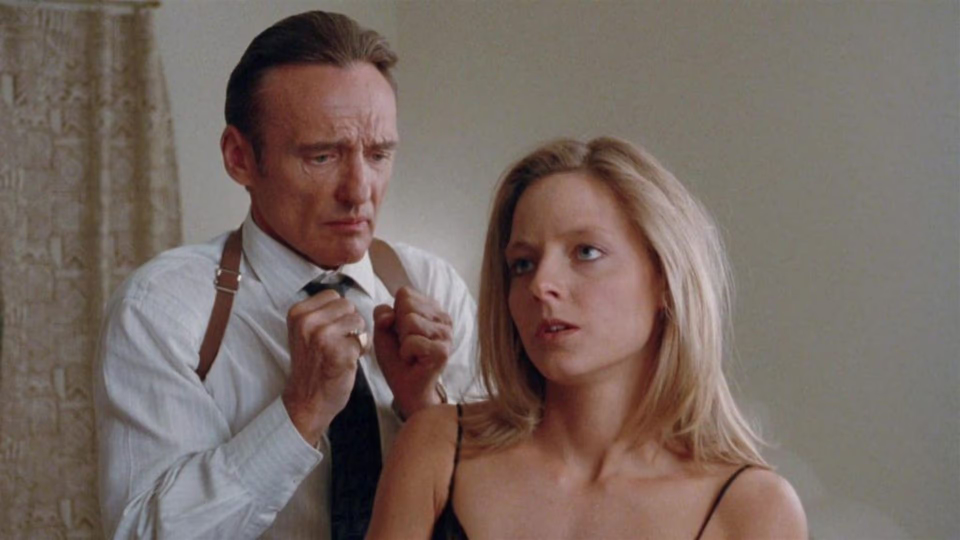Catchfire

Here is a film that occupies that peculiar place in cinema history where the collision between artistic ambition and studio interference creates something that is simultaneously unwatchable and oddly compelling. Dennis Hopper’s Catchfire bears the telltale scars of a project that began with vision and ended with Hopper disowning the final product, resulting in the infamous “Alan Smithee” credit.
The story itself reads like a fever dream: Hopper plays Milo, a hitman tasked by the mob to eliminate Anne (Jodie Foster), a witness to an execution. But rather than complete his assignment, Milo becomes obsessed with his target, kidnapping her instead. What follows is part Stockholm syndrome thriller, part romantic fantasy, part incoherent fever dream.
On paper, the cast reads like a cinephile’s wish list. Besides Foster, appearing just a year before her career-defining performance in The Silence of the Lambs, we get Joe Pesci (uncredited despite a sizable part) as the mob captain, Vincent Price as his aging boss, John Turturro as a weaselly mob henchman, Dean Stockwell as a smarmy lawyer, Fred Ward as a federal agent, and even Bob Dylan wielding a chainsaw as an artist.
It’s the kind of ensemble that suggests folks were eager to work with Hopper, whose direction shows flashes of genuine inspiration—there’s a remarkable moment early on where his character leaps across a rooftop gap, and mid-jump, we cut to him lurching forward in Foster’s bedroom, as if he’d jumped directly into her life. It’s the kind of visual poetry that hints at what this film might have been.
But that proves to be the creative high-water mark. What follows is a patchwork of bizarre choices that feel less like artistic decisions than the remnants of editorial panic. Milo inexplicably breaks into saxophone solos, hurls objects at windows, and delivers impromptu lectures on Native American history during helicopter chases. These moments don’t feel surreal so much as desperate—the flailing of a narrative that has lost its center.
The film’s schizophrenic nature becomes most apparent in its tonal shifts. It begins as a Hitchcockian thriller (complete with Foster in an ice-blonde wig and a North by Northwest-inspired plane sequence) before abruptly transforming into a romantic drama set against majestic mountain landscapes. You can almost hear the tonal gears grind as Foster calls Hopper a rapist in one scene, then swoons over him minutes later as violins swell on the soundtrack.
Foster herself emerges as the film’s saving grace. Despite reported on-set tensions with Hopper (she allegedly warned other performers against working with him), she emerges unscathed. The camera worships her, with key lighting accentuating her piercing blue eyes and wardrobe choices that flatter her lithe frame. Foster’s magnetic presence provides the film’s strongest anchor, making it watchable despite its structural flaws.
Hopper’s performance is less successful. Hidden behind dark sunglasses and hat, he seems to be channeling some amalgamation of Brando and Rod Steiger, but his Chicago accent feels like the affectation it is. There are moments when his acting becomes genuinely cringe-worthy, which raises an intriguing possibility: perhaps this is intentional.
The most charitable reading of Catchfire is that the entire narrative exists within Milo’s fantasies—that he’s not a hitman at all, but the meek owner of a Chicago laundromat who dreams of power, desirability, and expansion into a franchise empire. This would explain the accent, the occasionally wooden performance, and the mob’s inexplicable eagerness to employ his services. In this reading, we’re watching a small man’s large dreams, complete with the beautiful woman who falls for him despite all logic. Whether this interpretation was intended or is merely this reviewer’s attempt to impose coherence on chaos, it makes the film more palatable.
That said, the fingerprints of studio interference are all over this wreckage. When a director disowns his own work and hides behind the Alan Smithee pseudonym, it’s usually because the suits have taken scissors to his vision. Hollywood has a long, ignoble history of panicking when faced with unconventional material, and Catchfire bears all the hallmarks of a film re-edited by committee. The jarring tonal shifts, the inexplicable character beats, the sense that scenes have been rearranged like puzzle pieces that no longer fit—these aren’t the marks of a coherent artistic failure, but of corporate fear.
Still, Catchfire represents a particular kind of bad movie—the ambitious failure with flashes of brilliance. It’s objectively terrible—and yet strangely compelling. Foster’s performance alone justifies sitting through it, and the cavalcade of remarkable actors—even when they seem to be appearing in completely different movies—provides continuous interest.
Unlike a typical studio product that aims low and hits its mark, this film reaches for something more and fails spectacularly. In its broken form, it reveals more about the creative process than many successful films. For students of cinema and Hollywood history, it stands as a fascinating case study in how talented people, abundant resources, and genuine artistic ambition can still produce a magnificent mess.